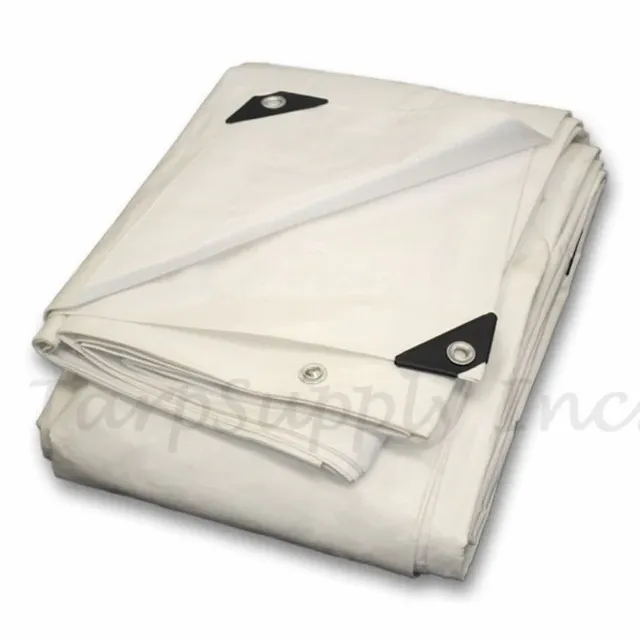
Poly tarps are versatile and reliable tools used for a wide range of applications, from protecting outdoor equipment and covering construction materials to safeguarding crops and providing temporary shelter. One critical factor to consider when selecting a poly tarp is its thickness, often referred to as its "mil" or denier rating. The thickness of a poly tarp plays a significant role in its durability, strength, and suitability for specific tasks. In this blog, we'll delve into the importance of choosing the right poly tarp thickness and guide you through the decision-making process, helping you make informed choices for your needs.
Understanding Poly Tarp Thickness
Before we dive into how to choose the right poly tarp thickness, let's first understand what thickness means in the context of poly tarps.
Mil vs. Denier Rating
Poly tarps are typically categorized by their thickness using two different metrics: mil and denier rating. Mil refers to the thickness of the tarp material, typically measured in thousandths of an inch (e.g., 6 mils). Denier, on the other hand, measures the weight or density of the material's fibers and is expressed in grams per 9,000 meters of the fiber (e.g., 1000 denier). While both metrics provide information about the tarp's thickness, they convey different aspects of its strength and durability.
Relationship Between Thickness and Durability
In general, the thickness of a poly tarp is directly related to its durability and strength. Thicker tarps tend to be more robust and can withstand harsher conditions, making them suitable for long-term and heavy-duty applications. Conversely, thinner tarps are often used for lighter tasks and temporary purposes.
Appropriate Thickness for Specific Tasks
Choosing the right poly tarp thickness depends on the specific tasks and conditions you'll be facing. Thicker tarps offer better protection against wear and tear, UV rays, and inclement weather, making them ideal for tasks such as covering construction materials, equipment storage, and long-term outdoor use. Thinner tarps, on the other hand, are more lightweight and flexible, making them suitable for temporary applications like camping, picnics, or as ground covers.
Factors to Consider When Choosing Poly Tarp Thickness
Now that you have a basic understanding of poly tarp thickness, let's explore the key factors to consider when selecting the appropriate thickness for your needs.
Intended Use and Duration
The primary consideration when choosing poly tarp thickness is the intended use and the expected duration of use. If you need a tarp for a short-term project or a one-time event like a weekend camping trip, a thinner tarp (e.g., 2 mils) may suffice. However, if you require long-term protection for valuable assets or materials, opt for a thicker tarp (e.g., 10 mils or more) that can withstand extended exposure to the elements.
Environmental Conditions
Take into account the environmental conditions your poly tarp will face. If you live in an area with extreme weather conditions, including heavy rain, snow, or intense sunlight, a thicker tarp is advisable. Thicker tarps are more resilient and better equipped to handle the challenges posed by severe weather, providing superior protection for your assets.
Weight and Strength Requirements
Consider the weight and strength requirements of your application. Thicker poly tarps typically have higher weight capacities and are better suited for tasks that involve heavy loads, such as covering machinery, building materials, or firewood. Ensure that the tarp you choose can adequately support the weight of the items it will cover.
Choosing the Right Poly Tarp Thickness for Your Needs
Now that you've assessed your specific requirements and considered the factors mentioned above, it's time to choose the right poly tarp thickness for your needs.
Light-Duty Tasks (1-3 Mil)
For light-duty and short-term tasks like protecting furniture during a move, covering a grill, or providing temporary shade at an event, a 1-3 mil poly tarp is suitable. These thinner tarps are lightweight, easy to handle, and offer basic protection against light rain and sunlight.
Medium-Duty Tasks (4-8 Mil)
When you need a poly tarp for medium-duty tasks such as camping, covering outdoor furniture for the winter, or protecting a vehicle from occasional rain or dust, opt for a 4-8 mil tarp. These tarps strike a balance between durability and flexibility, making them versatile for various applications.
Heavy-Duty Tasks (10+ Mil)
For heavy-duty and long-term applications, including construction site covers, boat and RV storage, and protecting valuable equipment, choose a poly tarp with a thickness of 10 mils or more. These heavy-duty tarps offer maximum durability, strength, and protection against the harshest environmental conditions.
Conclusion
Choosing the right poly tarp thickness is essential to ensure that your tarp meets the specific demands of your task while providing reliable protection for your belongings, equipment, or assets. By considering factors such as intended use, environmental conditions, and weight requirements, you can make an informed decision and select the perfect poly tarp thickness for your needs.
Whether you're tackling light-duty tasks, medium-duty projects, or heavy-duty applications, the right poly tarp thickness ensures that you have a dependable and long-lasting solution for your protection needs.